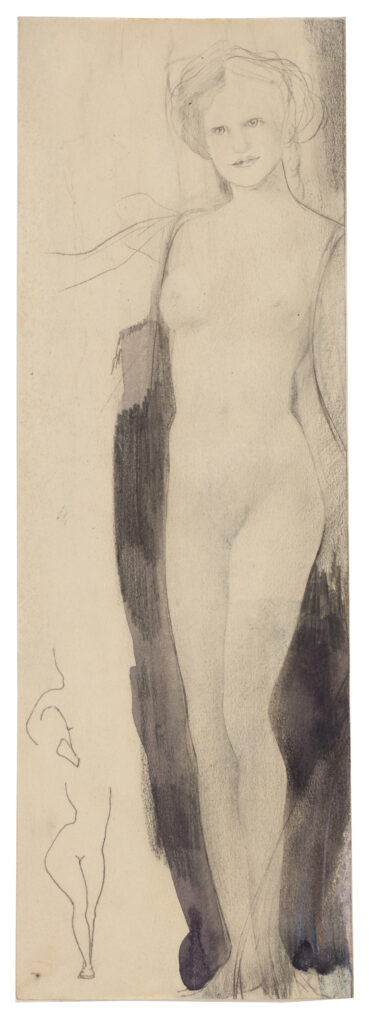
Christophe Karel Henri (Carel) de Nerée tot Babberich (Babberich 1880-1909 Todtmoos) Standing Nude. To be dated 1905-‘07. Pencil and watercolor on paper. 35,7 x 12,3 cm.
At the forthcoming Salon du Dessin in Paris, Onno van Seggelen Fine Arts offers a most interesting work by Carel de Nerée. Since I quite by chance happen to know a little bit about this artist, sir Onno asked me to write the article below. It was first published on his website.
**
Most people interested in Symbolism are familiar with De Nerée’s magnificent drawings. Less well known are his more naturalistic nudes and works that could be described as modernist. The sheet offered here is a fine example of both.
De Nerée’s modernist works were created between 1905 and 1907. The main features are deformed figures, the use of watercolor planes and abstracted landscapes. His main inspiration was Ferdinand Hodler. Mondrian was probably one of the few other Dutch artists to emulate the Swiss modernist during this period. These most interesting and rare works have always been sought after by a select group of art dealers and collectors interested in modernism.
More or less finished nudes by De Nerée are also quite rare. He must have drawn and painted around 50 nudes, which is considerable in an oeuvre of around 350 sheets, including sketches and drafts.
Nowadays, the whereabouts of only about fifteen of these more or less finished nudes are known. One reason for this is that they were considered too risqué.
During his lifetime De Nerée sold several works, mainly to German buyers. There were plans for a solo exhibition in 1904-05, but these never materialized. De Nerée was very reluctant to show his art to the conservative Dutch public. In August 1904 he wrote to the art critic Albert Plasschaert: ‘When I look at what is being made here and elsewhere, my work has always seemed to me to be special and highly refined. At the same time, I think, like you, that I am being silenced to death in Holland. Pourquoi pas?’
He was probably thinking of his many drawings of androgynous figures, lesbian-themed works and other works that can be called queer nowadays. An excellent example is the hatted androgynous nude from 1905-‘07 that Van Seggelen sold to the Rijksmuseum, Amsterdam in 2021. The present work is comparable in terms of style and technique. It also stems from the final stage of De Nerée’s artistry.
The first De Nerée exhibitions were held posthumously. From 1910 till 1914 they were on view in most Dutch major cities as well as in in München (Kunstverein), Dresden (Ernst Arnold) and Berlin (Keller & Reiner). The catalogues to the Dutch exhibitions mention only two nudes. It very much seems that some drawings were deliberately not exhibited. Plasschaert implies as much in his review of the December 1910 exhibition in Arti, Amsterdam: ‘This exhibition, I think, did not contain everything that an exhibition of this caliber should show. I suppose there must have things been left out, which one may find difficult to show because they were not made into ‘art’.’ Plasschaert could know as he was friends with De Nerée and wrote about his art several times.
And as late as 1926 the De Telegraaf wrote: ‘De Nerée, like Watteau, was voluptuous in spirit, but the erotiques, which he must also have made, are not shown. These things may have seemed too daring for prudish Holland. However rare a talent like De Nerée may be in Holland, this princely draughtsman, this gentleman-artist proves how conventional the image of the Dutch painter as a kind of artistically gifted citizen or peasant is.’
By contemporary standards the present work may not seem overtly erotic, but the suggestion of pubic hair and possibly high stockings make De Nerée’s intentions clear. De Nerée is generally considered a symbolist but many of his portraits of women are based on acquaintances or his lovers. De Nerée was possibly bisexual and had numerous affairs with women. Because of tuberculosis, from 1901 until his early death from the disease in 1909, he often had to spend long periods of time in sanatoria in Switzerland and Germany and where he met most of his female lovers. The woman depicted here could be one of them, though she has not been identified yet.
It’s fitting that this work later ended up in a German art collection. Only a catalogue survives of the Munich exhibition in September 1911. The selection of works shown in Berlin in November 1911 and in Dresden in early 1912 was probably the same. It is noteworthy that the German catalogue has 130 numbers as opposed to 116 in the Dutch version. The increase is mainly due to watercolored nudes in landscapes inspired by Hodler and pencil and pastel nudes. In these bastions of Expressionism, De Nerée’s more daring and modernist works seem to have been better understood and appreciated: a most interesting art-historical fact.
The Munich catalogue (no. 27) includes an additional study of a nude, which may well be the present work. The contours of the nude on the right make this sheet something of a study, but it is of course a fully-fledged work of art in its own right.
The Standing Nude thus represents the virtually unknown modernist side of De Nerée. But first and foremost, it is a small masterpiece by the artist.
Provenance: Gallery d’Audretsch (probably directly from the estate of the artist, conserved by the artist’s mother and brother till 1932); Amsterdam, Paul Brandt Auctions, 5 July 1966; Karel Citroen & Gallery Smidt, Amsterdam; Private collection, Germany.
Exhibitions: (Possibly: München, Berlin, Dresden 1911); London, Piccadilly Gallery, August 1966, cat. no. 32 (Standing Nude. Incorrectly dated ‘circa 1900’); München, Galleria del Levante, April-May 1970, cat. no. 31 (Standing Nude); Laren, Singer Museum, December 1974- January 1975, cat. no. 55 (‘Naaktstudie. Ca. 1905?’).
